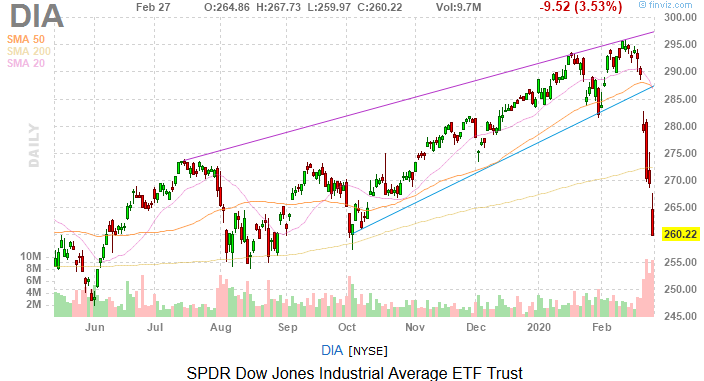Global stocks sunk to four-month lows Thursday, dragging bond yields lower, as fears intensified that the coronavirus from China is at epidemic stages, or worse and that it will be a significant drag on the global economy for some time.
- The S&P 500 slumped 4.42%
- The Dow Jones Industrial Average shed 4.42%
- The Nasdaq Composite plunged 4.61%
- Due to soaring surgical demands, 3M (NYSE:MMM) was easily the best-performing name in the Dow with a gain of 0.81%
Adding to the somber tone on Wall Street are reports out of California that the state is monitoring 8,400 people as possible coronavirus cases. I say this as someone that lives in the Golden State: spreading of the virus here would likely have severe repercussions for the broader U.S. economy — potentially dragging on the travel and leisure industry (looking at you Disneyland and Las Vegas) to technology and more.
California is home to four Dow components: Apple (NASDAQ:AAPL), Chevron (NYSE:CVX), Disney (NYSE:DIS) and Intel (NASDAQ:INTC), all of which have been taken to task by the coronavirus.
In late trading, 29 of the 30 Dow stocks were in the red.
Microsoft Mauled
Remember earlier this month when Apple yanked guidance for the current quarter due to supply chain issues in China? Microsoft (NASDAQ:MSFT) followed suit yesterday, pulling guidance for the quarter, citing the coronavirus. The news sent the stock lower by 7% today, making it one of the worst offenders in the Dow.
Microsoft remains a quality company with enticing fundamentals and lots of growth levers, including the Azure cloud business.
For investors that missed out on the 2019 pop in MSFT stock and have been waiting on a retreat, that pullback has arrived. The issue is pinpointing exactly when MSFT stock will cease faltering due to the coronavirus.
Intel Intrigue
In late trading, six Dow stocks were down at least 4% and semiconductor giant Intel was part of that group.
“Worries over COVID-19 have recently pressured semis … as of now most semi companies have not baked in much, if any, virus downside,” said Bernstein analyst Stacy Ragson in a note to clients today. “Given this, investors should likely be girding for semiconductor revisions in the near future as they may need to join the supply chain in lowering numbers.”
As is the case with tech brethren Apple and Microsoft, Intel remains a strong company, but one that is hard to buy over the near-term because the COVID-19 issue is far from settled.
Oil, Again
Exxon Mobil (NYSE:XOM) and rival Chevron (NYSE:CVX) have been making steady appearances in this space in recent weeks for all the wrong reasons.
Analysts continue opining on the fate of dividends paid by the two largest domestic oil companies (and others in the space). Exxon and Chevron yield 6.56% and 5.26%, respectively, and by some estimates the companies need oil at $87 per barrel and $57 to cover 2020 dividends. West Texas Intermediate closed around $47 a barrel today.
Not as Defensive as You Think
How bad are things getting for equities? Not one of the Dow’s consumer staples names — usually shelter from the storm havens — closed higher today. In fact, charts on some of these stocks, including Procter & Gamble (NYSE:PG), are looking ugly.
P&G slammed through its 200-day moving average today and is officially in correction territory. Compounding the woes of some staples names are frothy valuations that add risk to a sector that is often perceived to be low risk.
Bottom Line on the Dow Jones Today
Plenty of historical comparisons are being bandied about on the web about just how bad things have gotten. To be clear, the S&P 500 had two five-day selloffs in 2015 that were worse than the prior two days and two others in 2011.
That may constitute “good news” and that’s the problem. Even more problematic is the estimate that 94% of the Fortune 1000 have recently highlighted supply chain issues attributable to the coronavirus.
As of this writing, Todd Shriber did not own any of the aforementioned securities. He has been an InvestorPlace contributor since 2014.
